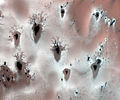Файл:Fractal defrosting patterns on Mars.jpg
Перейти до навігації
Перейти до пошуку

Розмір при попередньому перегляді: 719 × 600 пікселів. Інші роздільності: 288 × 240 пікселів | 575 × 480 пікселів | 921 × 768 пікселів | 1227 × 1024 пікселів | 2455 × 2048 пікселів | 3157 × 2634 пікселів.
Повна роздільність (3157 × 2634 пікселів, розмір файлу: 7,99 МБ, MIME-тип: image/jpeg)
Історія файлу
Клацніть на дату/час, щоб переглянути, як тоді виглядав файл.
| Дата/час | Мініатюра | Розмір об'єкта | Користувач | Коментар | |
|---|---|---|---|---|---|
| поточний | 19:01, 28 січня 2014 |  | 3157 × 2634 (7,99 МБ) | Tillman | {{Information |Description ={{en|1=This image is from the high latitudes in the Southern hemisphere, about half-way through southern spring. Just like on the Earth, the frost layer that accumulates over the winter will disappear as summer approache... |
Використання файлу
Така сторінка використовує цей файл:
Глобальне використання файлу
Цей файл використовують такі інші вікі:
- Використання в be.wikipedia.org
- Використання в en.wikipedia.org
- Використання в he.wikipedia.org
- Використання в sq.wikipedia.org
- Використання в th.wikipedia.org

